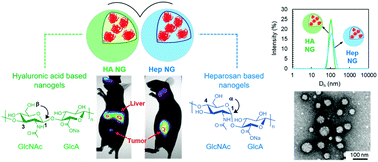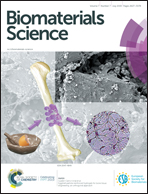Heparosan as a potential alternative to hyaluronic acid for the design of biopolymer-based nanovectors for anticancer therapy†
Abstract
Glycosaminoglycans (GAGs) are important components of the extracellular matrix that have attracted great interest for drug delivery and pharmaceutical applications due to their diverse biological functions. Among GAGs, heparosan (Hep), a biosynthetic precursor of heparin, has recently emerged as a promising building block for the design of nanoparticles with stealth properties. Though this non-sulfated polysaccharide has a chemical structure very close to that of hyaluronic acid (HA), it distinguishes from HA in that it is biologically inert in the extracellular spaces in the body. In this study, we designed Hep- and HA-based nanogels (NGs) that differ only in the chemical nature of the hydrophilic shell. The nanogels were prepared in a very straightforward way from Hep and HA modified with a thermoresponsive copolymer properly designed to induce self-assembly below room temperature. This versatile synthetic approach also enabled further shell-crosslinking allowing an increase in the colloidal stability. After careful characterization of the un-crosslinked and crosslinked Hep and HA NGs in terms of size (Z-average diameters of un-crosslinked and crosslinked NGs ∼110 and 150 nm) and morphology, they were injected intravenously into tumor-bearing mice for biodistribution experiments. Interestingly, these show that the liver uptake of Hep nanogels is remarkably reduced and tumor accumulation significantly improved as compared to HA nanogels (intensity ratios of tumor-to-liver of 2.2 and 1.4 for the un-crosslinked and crosslinked Hep NGs versus 0.11 for the un-crosslinked and crosslinked HA ones). These results highlight the key role played by the shell-forming GAGs on the in vivo fate of nanogels, which correlates with the specific biological properties of Hep and HA.



 Please wait while we load your content...
Please wait while we load your content...